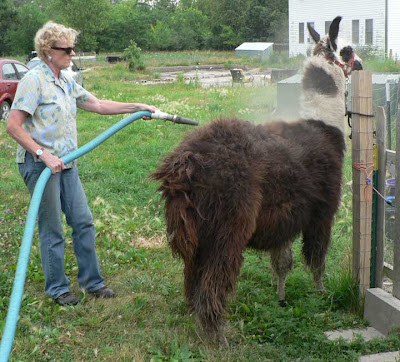 |
| Somehow the goats opened the gate today and came into the front yard. And they quickly found everything green! |
How long has it been since we've had any measurable amount of rain? I'm not entirely sure, but it's somewhere around seven or eight weeks. We are officially in an "extreme drought," according to the Drought Monitor. I've gone through all the usual stages of grief -- denial, anger, bargaining, and finally acceptance. There is still a part of me that is angry, but the logical part of my brain keeps telling me to just settle down. Acceptance is probably the most difficult thing for humans to learn.
This morning, we sent nine goats to be processed. They were wethers from last year that didn't sell. I had hoped to sell them this year, but most people don't want year-old pet goats, even at a discounted price. They want babies. The plan was to butcher them at the end of summer if they still didn't sell, but at this point, they were eating grass that is far too valuable for future pets that will sell for the cost of a few bales of hay, which they have already consumed. It wasn't that long ago that I said I could never butcher a goat, and it certainly was not easy bringing the boys into the barn last night, knowing where they would be going this morning. But I have to think of the welfare of all the animals out there. Unless there is a good reason to keep one, it has to go. And I really need to sell the sheep, or we will wind up with a freezer full of lamb and mutton by fall.
 |
| Carmen is pregnant and due to kid in 2-3 weeks. She really loves the weeds in the driveway. |
Finding no other alternatives, I decided to buy Chaffhaye, which is haylage. There wasn't a dealer within 100 miles of me, so I bought a truckload and can sell some to other people if they find themselves in a bind, unable to find hay for their animals. If no one buys any, I'll have plenty to feed my animals for more than a year. Yeah, that was pricey, but it's a good answer. I've heard more than one livestock producer say you should always have enough hay in storage to last for two years.
The garden isn't doing very well, but we've been able to keep everything alive. We aren't planting anything new. Although we're assuming we have a good water well, I don't want to take anything for granted because there are some people around here whose wells have run dry. The last thing I want to do is haul water from town. I've noticed a new water truck driving down our road the last couple weeks. Towards the end of next month, I'll plant some seeds for lettuce and other greens to overwinter in our low tunnels, but I'm not planting them until this horrific heat is passed.
Our pond is drying up, which is simply a constant reminder of our new reality. Every bit of dirt that you see in the photo above and below was covered with water two months ago.
I hope the crack willows don't die. They are accustomed to growing in the water, so I imagine they have pretty shallow roots.
On the bright side, we now know where all of our buckets disappear to!
But the sobering reality is that the situation is not expected to get better. The Drought Outlook shows the drought continuing through October at least.



















